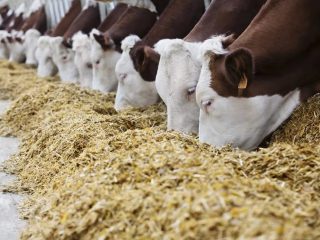Content
Bloody diarrhea in calves is a very broad concept. It is not a disease, but a symptom. Moreover, laboratory tests are often required to make an accurate diagnosis. It can only be stated unequivocally that in this case the gastrointestinal mucosa is damaged. But the reasons that caused these injuries can be many.
Why does a calf have bloody diarrhea?
Bloody diarrhea can be caused by:
- food poisoning;
- the ingress of a foreign body into the digestive tract;
- worms;
- infectious diseases.
All this can be the cause of bloody diarrhea in calves, but before starting treatment, you will have to identify the true cause. Worst of all is a foreign object in the gastrointestinal tract. If other problems can be dealt with on an outpatient basis, then there is only an operation. And it is beneficial if the calf is super valuable in breeding terms. In all other cases, you will have to hand it over for meat.
Poisoning not all lead to bloody diarrhea. Usually blood in excrement appears after feeding feed with chemicals:
- a lot of table salt;
- nitrates;
- salts of toxic metals;
- mycotoxins.
The latter is not a chemical, but a waste product of molds. Although cows are considered to be very resistant to eating such poisonous feed, they can also be poisoned.
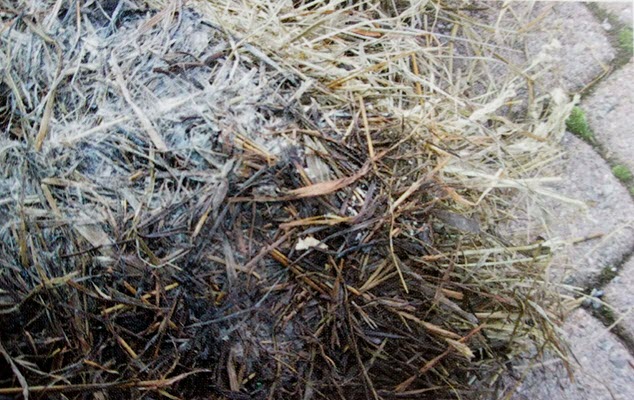
Hay in this state cannot be fed even in a mixture with good. It is not suitable for bedding either.
Sometimes it is necessary to feed the mold due to the fact that the purchased hay was poorly dried, and there is no other way to get it. But it is better not to give moldy feed to calves even in a mixture.
A large number of fluke worms in the digestive tract of a cow can also lead to the appearance of blood in the feces. The fluke attaches to the intestinal wall, damaging the mucous membrane. If there are few worms, blood is simply invisible, although it is present in the excrement.
Bloody diarrhea can also be a symptom of salmonellosis.
Since the causes of bloody diarrhea in a calf are different, it makes sense to start treatment after an accurate diagnosis has been established. Otherwise, you can lose time, during which the animal's condition will only worsen.
At the same time, viral diarrhea is normally called so precisely because of diarrhea as the main symptom of the disease. But the virus is very variable and there are many forms of diarrhea.
In adult bulls and cows, bloody diarrhea occurs for the same reasons as in calves. Only the percentage of causes changes: adult animals are more resistant to infections, and the reason for the development of diarrhea in them usually lies in poisonous feed. Adult cattle no longer get sick with diseases of young animals, although they can be a carrier of infection.
Why is blood diarrhea in calves dangerous?
Any diarrhea is dangerous, not only bloody. First of all, the fact that the body is dehydrated very quickly. Even pumping the body with a diuretic will not give such a quick and effective result as profuse diarrhea.
Bloody is dangerous not only for dehydration. With large damage to the intestinal mucosa, internal bleeding opens, which is very difficult to stop. Vessels inside cannot be pinched, as is done with external damage. A profuse bleeding in the intestines will result in the death of the calf within a few hours.
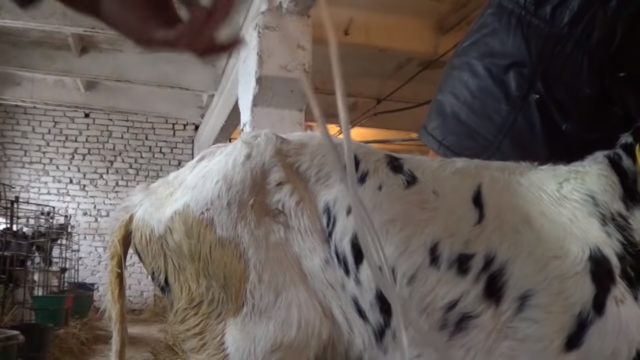
A calf dehydrated due to diarrhea looks emaciated
How to treat bloody diarrhea in a calf
Strictly speaking, treating calves only for diarrhea with blood is a futile exercise. If the cause is not eliminated, it will resume. But it takes time to establish an accurate diagnosis, during which the calf can die. Therefore, symptomatic treatment is first carried out:
- Removing the calf from feed. With bloody profuse diarrhea, they are still not absorbed, and solid particles can damage the walls of the gastrointestinal tract even more.
- Hemostatic injections.
- Antimicrobial therapy.
Injury in the intestine is a wide-open gateway for pathogens to enter the bloodstream. Therefore, with bloody diarrhea, in any case, antibiotics are prescribed.
It is possible to guess what caused the bloody diarrhea by the degree and speed of the spread of the disease. In isolated cases, the disease is most likely non-infectious and can be caused by an individual intolerance to any component in the feed. Also, a one-time case can be caused by ingestion of a foreign body. There may also be poisoning, but the calf ate the poison somewhere "on the side" while walking.
With a high content of substances poisonous to livestock in hay or feed, mass poisoning is possible. It usually occurs when new foods are introduced into the diet:
- a new batch of compound feed or hay;
- juicy feed supplementing the diet;
- fresh grass with poisonous plants or simply "burnt out".
But in this case, bloody diarrhea will begin in animals simultaneously with a maximum difference of several hours.
If the spread of the disease occurs rather quickly, but the number of calves with bloody diarrhea increases gradually, an infectious infection can be assumed. Based on these common signs, you can begin treatment before an accurate diagnosis is made, so as not to waste time.
Single case
The first step is to check for foreign bodies in the calf's gastrointestinal tract. Such equipment is available in large complexes, but hardly any of the private cow owners keeps an ultrasound scan and an X-ray machine at home. In addition, foreign body damage to the intestinal mucosa is an indication for surgery. It is better for a private owner to go straight to the emergency measures for poisoning. Nothing else can be done in a private courtyard.
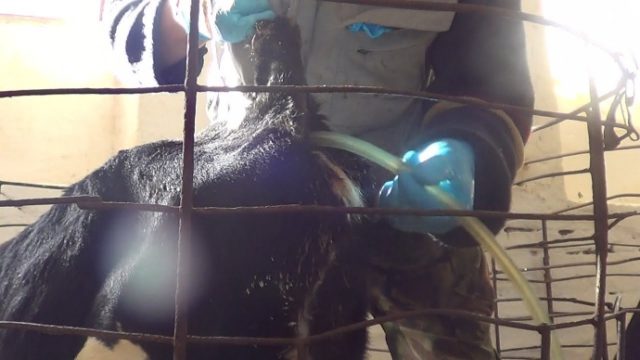
It is not easy to give an enema to a calf in case of poisoning, but it is necessary
Poisoning
The general principles of first aid for poisoning are the same for all poisons. In case of intoxication, a complex of various agents is used and they do it as quickly as possible.
First of all, the cause of the poisoning is eliminated. They remove suspicious feed from the access zone. Other measures, airing the room, are hardly relevant for bloody diarrhea in calves. Such diarrhea can also appear in case of poisoning through the respiratory tract, but this requires the use of BOV.
Further, if possible, remove the remnants of toxic substances from the gastrointestinal tract: washing, laxatives, enemas. Since on a free pasture, a cow can lie in something poisonous, and then lick the poison from the skin, the animal is thoroughly washed. But this is when you suspect the presence of poison on the wool.
To remove it from the body, the calves are given various sorbents: activated carbon, white clay, enterosorbent B, polyphepan, smecta.
For acid poisoning, sodium carbonate is used.
To remove the already absorbed poison, intravenous administration of saline, glucose, diuretics and laxatives is used. In simple terms, "put a dropper." If it is known with what poison the calf was poisoned, an antidote is administered to it.
Therapy is carried out, which is aimed at increasing immunity, improving metabolism, maintaining the respiratory, cardiovascular and other systems of the body.
If poisoning is suspected, even if it was an isolated case, feed and water are urgently sent for analysis to a laboratory.Frankly speaking, it is unlikely that a private owner will do this.
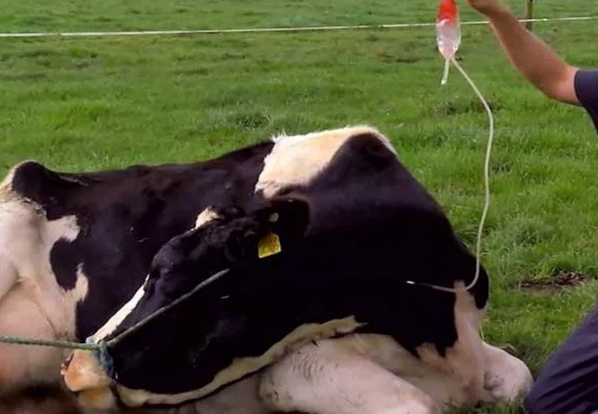
Often, the dropper has to be placed directly on the pasture, taking over the functions of a rack for a container with a medication
Helminths
Large numbers of worms in the intestines can be life-threatening for the calf. Even roundworms can become tangled and cause mechanical blockage of the gastrointestinal tract. The use of strong anthelmintic drugs causes the death of parasites. With a small population, the dead worms will pass out of the intestines without causing problems. But if there were a lot of worms, the toxins from the decaying corpses will penetrate the blood of the calf and cause general intoxication of the body.
Salmonellosis
The appearance of bloody diarrhea in a calf with salmonellosis means an already advanced stage. Since an accurate diagnosis is made on the basis of laboratory tests, one can only assume what caused the disease, based on additional symptoms:
- heat;
- thirst;
- conjunctivitis;
- signs of pneumonia;
- bloody diarrhea.
Treatment is carried out with broad-spectrum antibiotics. To maintain the body, vitamin and mineral preparations are administered.
Preventive actions
It is impossible to prevent only bloody diarrhea. Measures must be taken to prevent the causes of diarrhea. And always keep in mind that diarrhea, "normal" or bloody, is only a symptom of the disease.
Prevention of the ingress of foreign bodies into the stomach is carried out by cleaning the area where the cows walk. So that cattle does not try to compensate for the lack of vitamins and minerals by eating various inedible items, they are provided with a complete diet with the addition of vitamin and mineral premixes.
To prevent poisoning, you must:
- comply with the technologies of harvesting and storing feed;
- constantly monitor their quality;
- not to violate the technology of preparing feed and preparing them for feeding;
- check the condition of reservoirs and pastures.
Moldy and fermented feed should not be fed to calves either. If freshly cut grass has been piled up and warmed up on its own, it should not be given to animals. Any food with an unnatural color or rot is excluded from the diet. Veterinary specialists are obliged to constantly monitor the composition of plants in nearby forests and meadows, whether fertilizers or pesticides were used in grazing areas. All these measures are impossible in a private economy.
For the prevention of worms, it is enough to follow the deworming schedule. In this case, the parasites will not have time to multiply to a critical number. Infection with eggs and larvae of worms of healthy animals is prevented by sanitizing pastures.
Preventive measures to prevent salmonellosis are the same as for other infectious diseases:
- regular disinfection of equipment and instruments;
- keeping litter clean;
- storage of food and water in a place inaccessible to rodents;
- disinfection of overalls for personnel;
- quarantine for newly arrived animals;
- providing calves with a complete diet.
Compliance with sanitary and veterinary requirements for keeping livestock significantly reduces the risk of infectious diseases.
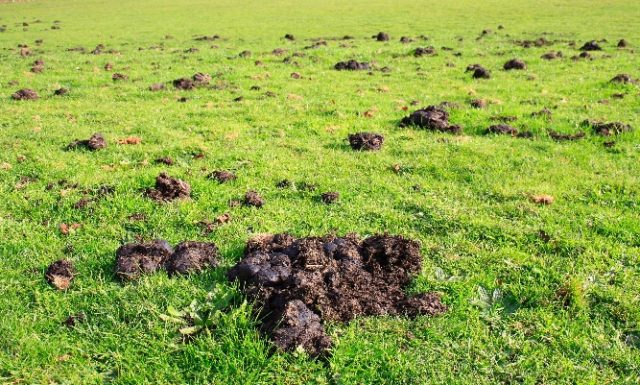
Regular cleaning of pasture from manure will protect calves from unnecessary problems
Conclusion
Bloody diarrhea in calves is an extreme disease that can be avoided if you closely monitor your animal. The only exception is a foreign object. But here it is difficult for a private trader to keep track of what exactly his cow captures when eating grass.





